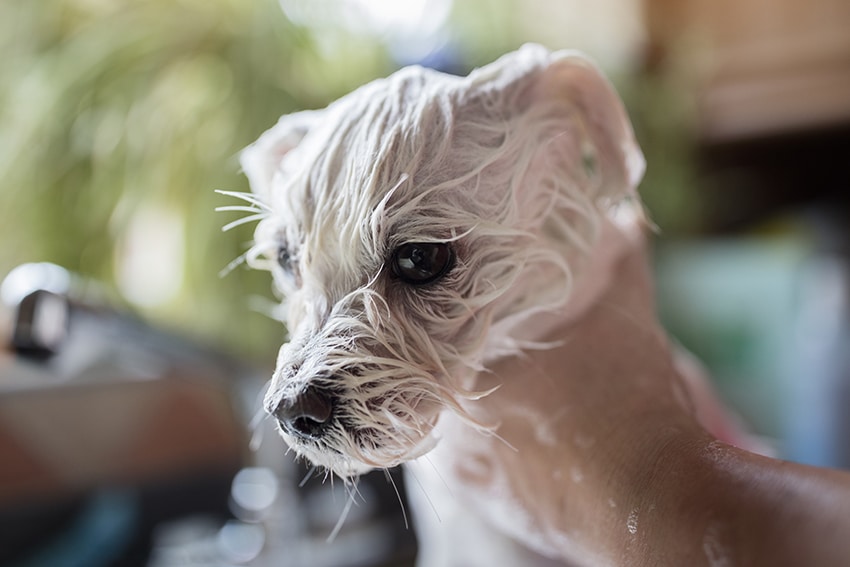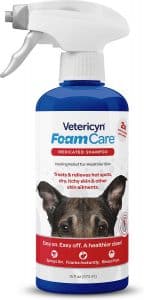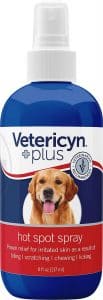Hot spots are a nightmare for both pup and pawrent, you can almost feel your pet’s pain and itchiness when you see these nasty, reddened crusts on your fur-baby’s skin. In this article, we’ll give you a rundown on some of the available hot spot shampoos for dogs to help soothe your pup’s skin.
- Best hot spot shampoo for dogs: Vetericyn FoamCare®
- Best hot spot spray for dogs: Vetericyn Plus®
- Our Runner-up pick: Veterinary Formula Clinical Care
- Best for budget: Vet's Best
Shampoos
Vetericyn FoamCare Medicated Pet Shampoo
This foaming shampoo is medicated to help clean and soothe a variety of minor skin issues for pups. This anti-inflammatory shampoo doesn’t strip your pet’s skin of its natural oils and is hypoallergenic so it’s suitable for even sensitive pooches.
How does it work?
Active ingredient: Salicylic acid
What We Like About It?
- Hypoallergenic, this product conditions the skin and doesn’t strip away oils
- Free from parabens, sulfates, chemical dyes, and fragrances
- Anti-inflammatory and doesn’t damage the skin cells needed to heal wounds
Vet’s opinion
Veterinary Formula Clinical Care Hot Spot & Itch Relief Shampoo
How does it work?
Active ingredient: Hydrocortisone and lidocaine
What We Like About It?
- Safe for use with topical “spot-on” flea and tick preventatives
- Contains proven compounds to soothe and relieve pain and inflammation
- Satisfaction Guarantee within the USA
Vet’s opinion
This medicated shampoo contains clinically proven lidocaine and hydrocortisone which will help relieve your pup’s pain while targeting and reducing the inflammation. Paraben and dye-free, this shampoo also contains allantoin which protects and aids in skin healing. This product has the added benefit of being safe to use without affecting the action of flea and tick medications.
Vet’s Best Hot Spot Shampoo for Dogs
How does it work?
Active ingredient: Tea tree oil, aloe vera, chamomile, allantoin, panthenol, and vitamin E.
What We Like About It?
- Natural ingredients for a no-sting application to inflamed skin
- Safe for dogs over 12 weeks of age
- Veterinarian formulated
Vet’s opinion
Vets Best Hot Spot Relief Shampoo is a blend of natural ingredients including allantoin and vitamin E and panthenol to help support skin healing. Made in the USA, this shampoo is safe for puppies over 12 weeks and doesn’t interfere with topical flea and tick preventative medications.
NaturVet – Septiderm-V Skin Care Bath
How does it work?
Active ingredient: Cetyltrimethylammonium bromide (CTAB)
What We Like About It?
- Suitable for puppies as young as 6 weeks old
- Deodorizing and cleansing without stripping the natural skin oils of your pup
- Easily rinsed away
Vet’s opinion
Relief from itching while also cleaning your pup’s mucky coat means you don’t need to use multiple products that may exacerbate their skin problems. As it can be used on puppies from just 6 weeks old, it’s great for those who have scratched their skin raw from a flea infestation.
Sprays & Gels
Vet’s Best Dog Hot Spot Itch Relief Spray
How does it work?
Active ingredient: Tea tree oil, Chamomile & Aloe vera
What We Like About It?
- Non-sting and fast-acting relief
- Plant-based with natural ingredients
- Steroid-free
Vet’s opinion
This spray is a convenient, plant-based product that can be used to soothe minor skin irritations on sensitive skin without having to fully bathe your fur-baby. Veterinarian formulated and steroid-free, this spray doesn’t interfere with topical flea and tick products.
Vet's Best Quick Soothe Hot Spot Foam for Dogs
How does it work?
Active ingredient: Tea tree oil, Chamomile & Aloe vera
What We Like About It?
- Non-sting and fast-acting relief
- Plant-based with natural ingredients
- Steroid-free
Vet’s opinion
This spray is a convenient, plant-based product that can be used to soothe minor skin irritations on sensitive skin without having to fully bathe your fur-baby. Veterinarian formulated and steroid-free, this spray doesn’t interfere with topical flea and tick products.
Vetericyn Plus® Hot Spot Antimicrobial Hydrogel
How does it work?
Active ingredient: Hypochlorous acid
What We Like About It?
- Creates a barrier between wounds and the environment
- Suitable for use on the most sensitive skin
- Non-toxic if ingested
Vet’s opinion
Gentle, non-toxic, and safe for all ages of pet, this hydrogel provides moisture and a protective barrier for damaged skin. Non-toxic, this is suitable for pets of all ages, even the most sensitive pooches.
Vetericyn Plus® Hot Spot Spray
How does it work?
Active ingredient: Hypochlorous acid
What We Like About It?
- Safe for all skin types
- Non-toxic formula
- Great for your pet’s First Aid Kit, not just for “hot spots”
Vet’s opinion
Instantly-cooling and non-stinging, Vetericyn Plus Hot Spot Spray is a great product to use the second your pup starts scratching. Promoting healing, providing moisture, and protecting delicate, new skin cells this safe product can be used multiple times per day.
NaturVet – Aller-911 Hot Spot Allergy Aid Foam Plus Aloe Vera
How does it work?
Active ingredient: Witch hazel, Tea tree oil, Aloe vera extract, Bittering agent
What We Like About It?
- Quick-drying, foam with soothing aloe vera
- Suitable for use with spot-on parasite products
- Quiet foam dispenser
Vet’s opinion
Aller-911 is a soothing foam containing both aloe vera and the astringent, witch hazel that provides rapid relief for pups with skin irritations. Prevents chewing through the use of a bittering agent within the product.
Zymox Topical Hot Spot Spray for Dogs and Cats with .5% Hydrocortisone, 2oz
How does it work?
Active ingredient: Hydrocortisone 0.5%
What We Like About It?
- Non-toxic, antibiotic-free and no-sting formula
- Suitable for a range of minor skin ailments
- Reduces swelling and itching while soothing skin with added aloe vera
Vet’s opinion
Zymox topical spray contains a mild concentration of the steroid, hydrocortisone to help reduce swelling and soothe inflammation caused by “hot spots” and mild skin infections. Containing a patented LP3 enzyme system and added aloe vera, the product aims to promote healing of the skin. Suitable to use on minor cuts and abrasions as well as dermatitis.
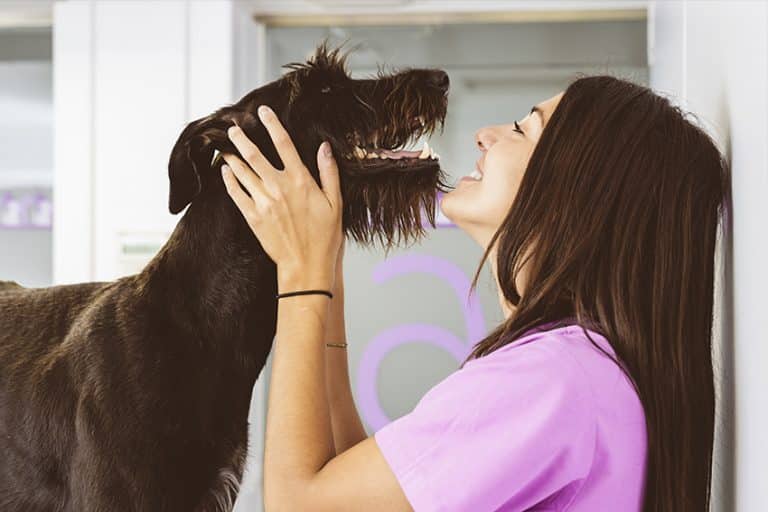
Did you know?
“Hot spots” aren’t just the purview of sensitive pups with allergies. Any irritation or pain site has the potential to become a “hot spot” due to the excessive attention paid to the area by chewing and licking which damages the skin allowing microbes to invade and start an infection.
“Hot spots” spread fast and seem to come out of nowhere. One day, you’re stroking your pet and find this small, angry, red, painful patch of skin and suddenly it seems to be spreading day by day. Once these irritated areas are infected they develop and expand exponentially.
Understanding hot spots on dogs
Also known as pyoderma or acute, moist dermatitis, hot spots are skin infections are caused by commensal (normal) bacteria that live on the skin. Sometimes these bugs override a dog’s immune system to damage the skin itself. The affected area then reddens (inflammation), and becomes intensely itchy.
Affected pets then scratch the area, which then becomes moist and infected. As pus oozes out it dries and forms tough crusts which cause hair loss and are really painful when touched. These spots can grow quite fast so treatment early on is key. As a vet, I tend to see hot spots more during the warm, humid summer days though some pets can be affected all year round.
What causes hot spots?
- Bug bites: Fleas, flies, and ticks love to have a munch on our fur-babies. These bites cause a little inflammation which, when your pet scratches it can become even itchier. This can kick-start a vicious cycle which leads to the development of a hot spot.
- Allergies: Some pooches have allergies to lots of things and similar to us humans, these can be incredibly itchy. When our pups scratch, they traumatize their skin which can allow bacteria to set up a new home in the wounds. These wounds are also irritating to our pets causing more scratching.
- Excess moisture: Continual licking or over-grooming can lead to increased levels of moisture on a pet’s skin which weakens the skin’s natural barrier oils allowing bacteria to enter the skin, allowing a “hot spot” to develop.
- Dense hair coats: Dogs with heavy, long hair or double-coats are more prone to “hot spots” than light coated pooches. This is related to how well their fur traps moisture close to the skin, particularly if they’re water-pups.
- Pain/Inflammation: Some “hot spots” can be an indication that your pup has pain underneath and not just parasites. If your pup develops a “hot spot” over their hip or near their bum it may be that they have arthritis or an anal gland infection that originally caused them to start licking/biting at the area. One common place we see “hot spots” is just below the ears which can indicate that the dog has an ear problem or dental pain.
Treatment for Hot Spots
How to treat a small, non-painful “hot spot” at home
- Clip the hair from the hot spot and the surrounding area will help allow the air to circulate around the affected skin.
- Gentle cleansing of the inflamed/infected skin will help to lift any crusty scabs from the skin underneath. This allows for the removal of pus which can make the infection worse. If you use a medicated shampoo*, ensure it is fully rinsed away.
- The area should then be patted dry gently to help remove extra moisture. Don’t apply any bandages!
- Prevent your pet from licking/scratching the area as this can make the hot spot worse.
There are lots of products available but you should always check with your veterinarian before using anything. Many human products can be toxic to our canine companions.
Veterinary treatments come in a number of guises but include antibiotics, anti-inflammatory drugs or steroid medications to help treat the inflammation and infection. Your veterinarian will also advise an e-collar or similar to protect the “hot spot” from your fur-iends paws and tongue as they strive to scratch the intense itchiness.
Some pups are in so much pain from a “hot spot” that your veterinarian may need to sedate or anesthetize them in order to clip and cleanse the area. Your vet may also culture the bacteria or perform cytology (look at cells under a microscope) to determine the best medication for your pooch.
Preventing Hot Spots
- Parasite prevention: Rigorous flea and tick prevention is important. Flea and tick bites can be painful and cause significant skin irritation. This irritation is even more intense if your fur-baby has a flea bite allergy.
- Grooming: Regular grooming helps to remove dead hair and skin cells which can cause itchiness, similar to dandruff in humans. If your pooch has a thick, heavy, or long coat, regular grooming helps to prevent matting of their fur. Matted fur traps moisture and dead cells which create the perfect environment for irritation and infection to brew, forming “hot spots”. If you have a water-pup, thorough drying of their fur is essential following a swim or a bath.
- Alleviating allergies: If your pup has been diagnosed with an allergy then appropriate management is essential to prevent itching and thus your pet traumatizing their skin. Management of allergies comes in different forms and may include dietary modifications or medications.
- Environmental enrichment: Some of our fur-iends struggle with being left alone and can become stressed or bored. Often, we see these pets lick or chew areas of their skin which can rapidly turn into “hot spots”. Puzzle toys, games, and extra exercise can help to keep your pup mentally stimulated.
- Skin supplements: Studies have shown that fatty acids are needed to keep skin healthy and a little extra supplementation can help. Docosahexaenoic (DHA) and eicosapentaenoic (EPA) acids are two of the omega-3 fatty acids found in high concentrations in fish oils. There are lots of omega fatty acid supplements on the market (You can check this out in our …...). One such popular supplement is Zesty Paws Allergy Immune Supplement for Dogs - with Omega 3 Wild Alaskan Salmon Fish Oil & EpiCor + Digestive Prebiotics & Probiotics.
F.A.Qs
Some small “hot spots” can be treated at home. Non-painful, small areas of irritation can be treated at home. Remember though, these can rapidly expand and if your pet is painful or there is any indication of infection you should make an appointment with your vet. If you’re not sure, always contact your veterinarian in the first instance.
“Hot spots” tend to not cause sickness such as vomiting or diarrhea in pets. The stress, itching, and pain that comes with the infection, however, will make your fur-baby miserable and depressed. As “hot spots” spread so quickly, they can develop into serious infections which can make your pup very ill.
Benadryl cream may be used to relieve an itch, however, you should contact your veterinarian before using any human medications to ensure it’s appropriate. The cream isn’t a substitute for clipping and cleansing the irritated areas.
Our verdict on hot spot shampoos for dogs
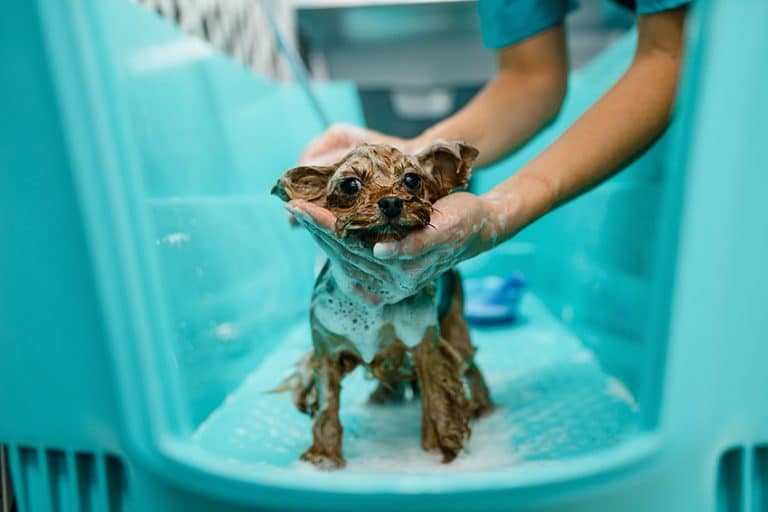
Vetericyn FoamCare Medicated Pet Shampoo stands out for us, it ticks all the boxes a pawrent wants to soothe their sensitive pup’s hot spots.
Spray-on with instant foam action this shampoo is so easy to use and easily rinses out of even the thickest fur coat. Vetericyn has developed a hypoallergenic, paraben-free medicated shampoo that’s plant-based and fragrance-free.
The active ingredient, salicylic acid, helps to exfoliate dead skin cells and crusts from irritated areas to expose the new tissue to fresh air.
It also helps to reduce the production of oil in the skin, helping to dry the “hot spot” and improve healing.
Soothing aloe and added allantoin help to reduce inflammation while promoting healthy, new skin growth.
No antibiotic formula means you don’t need to worry about increasing the risk of resistance in bugs. Vetericyn is the top dog in the available “hot spot” shampoos for dogs; the delicate blend of science and natural ingredients produces a product that is a must-have for all first-aid kits for pups.

